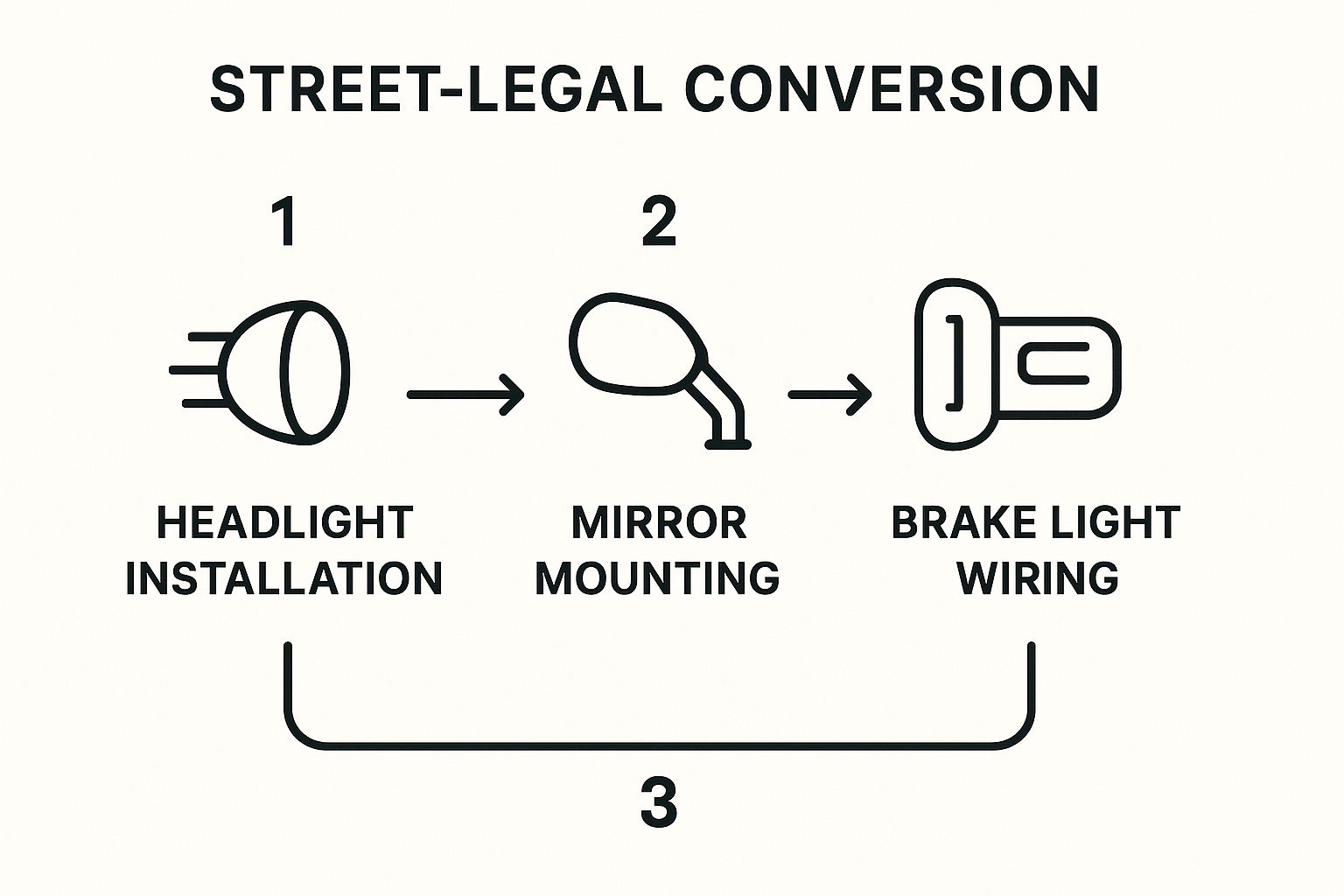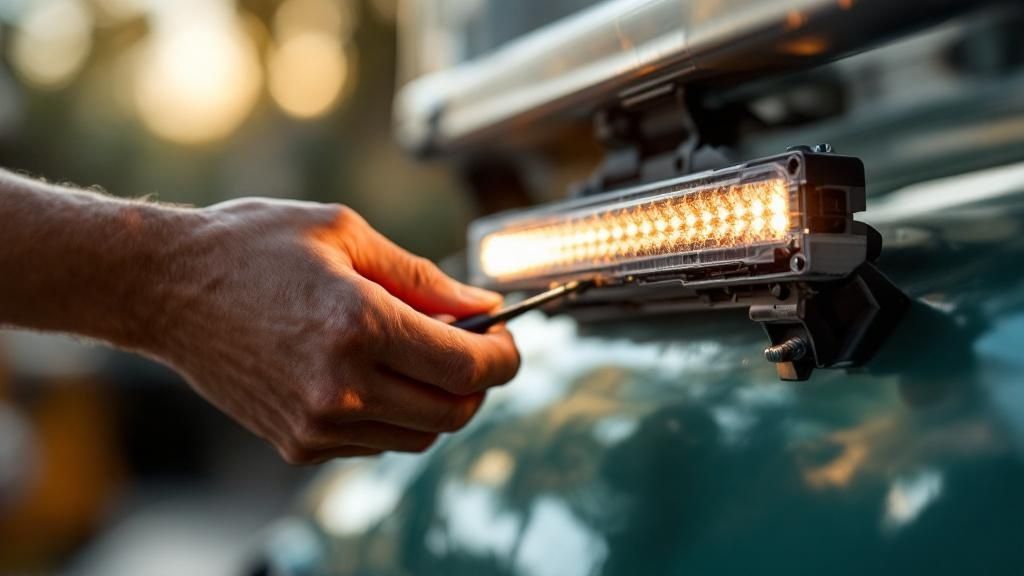Ready to take your golf cart from the fairway to the street? Making it street legal involves a specific process of upgrading its equipment to comply with local and state laws. Once you've done that, you'll need to get it properly titled, registered, and insured as a Low-Speed Vehicle (LSV).
It's a process that turns your fun ride into a road-ready machine, but you have to be meticulous about the legal details.
The Path to Making Your Golf Cart Street Legal

Transforming a standard golf cart into a street-legal LSV is a fantastic project, but let's be clear: it's more involved than just bolting on a few new parts. The whole journey hinges on understanding the legal standards and safety gear that separate a simple course cruiser from a vehicle that's actually permitted on public roads.
Think of it this way: you're essentially giving yourself the freedom to pop over to the local store or visit a neighbor without firing up your primary car. This guide will walk you through the essential equipment you'll need and the paperwork—like titling and registration—that comes with it.
The ultimate goal here is to elevate your cart from a vehicle that's only allowed on private property to one that is officially recognized by your state as a Low-Speed Vehicle. This classification is the key to everything else, from getting a Vehicle Identification Number (VIN) to mounting a license plate.
A Look at Standard vs. Street Legal Carts
To really see what's involved, it helps to compare a basic golf cart with a fully equipped LSV. The difference is all in the details and the safety features.
Here's a quick breakdown of what separates the two:
Standard Golf Cart vs Street Legal LSV Equipment
| Feature | Standard Golf Cart | Required for Street Legal (LSV) |
|---|---|---|
| Headlights/Taillights | Often optional or basic | Required, must be DOT-approved |
| Turn Signals | Not included | Required (front and rear) |
| Brake Lights | Not always standard | Required and must be operational |
| Windshield | Plastic, foldable | Required, DOT-approved shatter-resistant material |
| Mirrors | Typically none | Required (rearview and side-view) |
| Seat Belts | Not included | Required for all seating positions |
| Horn | Sometimes included, but weak | Required, must be audible from 200 feet |
| Speedometer | Not standard | Required to monitor speed |
| Reflectors | Minimal, if any | Required on all sides of the vehicle |
| VIN Plate | Not included | Required for registration and titling |
As you can see, the list of mandatory upgrades is pretty extensive. Each piece of equipment is designed to make the vehicle safe for you and everyone else on the road.
Planning Your Conversion Budget
So, what's all this going to cost? The total can run anywhere from a few hundred to several thousand dollars. It really depends on what your cart already has and the quality of the parts you decide to install.
As you map out your budget for the necessary modifications and fees, you might want to look into different financing options. Exploring current equipment loan rates can give you a clearer picture of what's available.
You’ll definitely need to budget for these key components:
- A full lighting kit: This includes headlights, taillights, turn signals, and brake lights.
- Vision and safety gear: A DOT-approved windshield is non-negotiable, as are rearview and side-view mirrors.
- Passenger security: You'll need to install seat belts for every seat.
- Road compliance items: This means a proper horn, an accurate speedometer, and reflectors.
This overview should give you a solid foundation to decide if converting your golf cart is the right move for you and, just as importantly, what it takes to get it done right.
Navigating Your Local Golf Cart Laws

Before you buy a single part or turn a single wrench, your first and most important job is to get intimately familiar with your local laws. I can't stress this enough. The rules for street-legal golf carts aren't the same everywhere; they can change dramatically from one state to the next, and sometimes even between neighboring towns.
Skipping this homework is a surefire way to waste money on parts you can't use or, worse, get hit with fines for driving a non-compliant vehicle. What flies in a Florida retirement community might be completely off-limits in a quiet Arizona suburb.
Your research should start at the state level. Head over to your state's Department of Motor Vehicles (DMV) or Department of Transportation (DOT) website. When you search, don't just type in "golf cart." You'll get much better results by using the official lingo.
Pro Tip: Search for official terms like “Low-Speed Vehicle” (LSV) or “Neighborhood Electric Vehicle” (NEV). These are the legal classifications that state statutes are built around, and using them will lead you directly to the regulations you need to follow.
Digging into State-Level Rules
The state DMV or DOT website will give you the foundational requirements for your build. You'll find out the maximum speed your vehicle can legally travel (federally, this is capped at 25 mph for an LSV) and what kinds of roads are permissible. Typically, this means streets with a posted speed limit of 35 mph or less.
This is also where you'll find the master list of required safety equipment. Common mandates include:
- Headlights, taillights, and working brake lights
- Front and rear turn signals
- A DOT-approved, shatter-resistant windshield
- Seat belts for every passenger spot
- A horn that can be heard from at least 200 feet away
Think of these state laws as your minimum standard. For instance, Florida has pretty clear state-wide LSV laws, but a state like Arizona lets individual cities and towns set many of their own rules. This brings us to the next critical layer of your research.
Uncovering Local Ordinances
Never make the mistake of assuming the state law is the final word. Your local municipality—whether it's a city, town, or county—often tacks on its own specific restrictions. This is where a lot of people get tripped up.
These local ordinances can cover things the state doesn't even mention. I've seen it all:
- Restricted Hours: Some towns won't let you operate an LSV after dark, even if you have brand new headlights.
- Specific Road Prohibitions: A city might ban LSVs from certain busy streets, even if the speed limit technically allows for them.
- Tougher Driver Requirements: While the state might just require a valid driver's license, a local ordinance could add its own age restrictions.
So, how do you find these hyper-local rules? Your best bet is to check your city or county's official website and look for their code of ordinances. Honestly, sometimes the easiest way is to just make a quick call to city hall or the local police department's non-emergency line. Getting the information straight from the source is the only way to be certain you're building a vehicle that's truly street-legal for your specific area.
Installing Essential Safety Equipment
Once you've got a handle on your local laws, it’s time to roll up your sleeves and get to work. This is the fun part—turning your golf cart from a simple course cruiser into a road-worthy vehicle, one component at a time. Getting a golf cart street legal really boils down to adding the right safety gear required for public roads.
This isn't just about bolting on a few parts. It’s about careful selection and proper installation. I can't stress this enough: choose quality, DOT-approved components over cheap knockoffs. It's not just a suggestion; it's absolutely vital for passing your inspection and, more importantly, keeping yourself safe out there.
Lighting and Visibility Upgrades
First things first, let's talk about lights. On the road, being seen is every bit as important as seeing what's in front of you.
A complete lighting system is your top priority. This usually means installing:
- Headlights and Taillights: These are a must-have for driving anytime after dusk.
- Brake Lights: They need to work just like a car's, lighting up automatically when you hit the brake pedal.
- Turn Signals: You'll need both front and rear signals to let other drivers know your intentions.
Many people find it easiest to buy an all-in-one street legal light kit, which can simplify the wiring. But if you're sourcing parts yourself, double-check that every component is compatible with your cart's voltage system. A common mistake I see is a "rat's nest" of wires. Use wire looms and zip ties to keep everything tidy and protected from the weather.
Remember, the goal isn't just to have lights, but to have a reliable system that works every single time. Faulty wiring is a top reason for failed inspections and can be a serious safety hazard on the road.
Windshield, Mirrors, and Reflectors
Clear vision is non-negotiable. That flimsy plastic windshield that came with your cart simply won't do for road use. You'll need to upgrade to a DOT-approved, shatter-resistant windshield. Some areas even require windshield wipers, so be sure to check your local rules on that.
Next up, mirrors. You need to eliminate those dangerous blind spots. At a bare minimum, you'll need:
- A wide-angle rearview mirror.
- Two side-view mirrors (one for the driver's side and one for the passenger's side).
Reflectors are another small but crucial addition. They make your cart visible from all angles in low light, even when it's just parked on the side of the road. You’ll need to place them on the front, back, and both sides of your cart.
This image gives you a great visual breakdown of the key upgrades for your cart's visual and electrical systems.

As you can see, getting your lights, mirrors, and brake lights properly installed forms the foundation of a safe, street-ready vehicle.
Essential On-Road Accessories
Finally, there are a few more pieces of hardware you'll need to be fully compliant. A horn that can be heard from at least 200 feet away is a universal requirement. It's your primary way of alerting pedestrians and other drivers.
You’ll also need to install a speedometer. This is essential for making sure you’re staying within the posted speed limits, especially since Low-Speed Vehicles (LSVs) are typically restricted to roads with speed limits of 35 mph or less.
Seat belts for every single passenger seat are also mandatory. This is one of the most important safety features, protecting everyone on board in case of a sudden stop or collision.
Before you go for your official state inspection, do yourself a favor and double-check everything you've installed. Going over the common vehicle inspection checklist items will help you spot any issues and make sure all your safety equipment is working perfectly. It's the best way to avoid the frustration of a failed inspection.
Getting Through the State Inspection and Titling Maze

Alright, you've bolted on all the required safety gear. Now comes the part that often feels the most intimidating: dealing with the state. This is where you navigate the world of paperwork, inspections, and titling to officially transform your golf cart into a legal Low-Speed Vehicle (LSV).
Think of this as the final exam. It's where all your hard work gets the official stamp of approval, turning your modified cart into a machine that's recognized and permitted on public roads. Let's break down how to get it done without pulling your hair out.
Scheduling Your Official Inspection
First things first, you need to schedule an official inspection. You can't just roll up to your local DMV. Most states have designated facilities for this specific kind of verification—it might be a special DMV inspection station, a certified police department, or even a state highway patrol barracks. The best way to find out where to go is a quick call to your state's DMV.
When you arrive for your appointment, an inspector is going to go over your cart with a fine-tooth comb. This isn't just a quick glance. They have a checklist, and they will be verifying every single upgrade.
Here's what they're looking for:
- DOT-approved markings on the windshield and tires. No sticker, no pass.
- Functioning lights. They'll test the headlights, taillights, brake lights, and turn signals to make sure they all work as intended.
- Proper installation. Expect them to check that the mirrors are secure, the seat belts are properly anchored, and the horn actually makes noise.
- General roadworthiness. They'll give the whole cart a once-over to ensure it looks and feels safe.
My advice? Double-check everything yourself before you go. It'll save you the headache of a failed inspection and a return trip.
The Paperwork Gauntlet and Getting a VIN
With a passed inspection slip in hand, you're ready to tackle the title. The documents you need depend on your cart's history. If you bought it new, you’ll use the Manufacturer's Certificate of Origin (MCO). This is basically the cart's birth certificate and makes the process pretty simple.
It gets trickier with used carts. Ideally, you have a signed bill of sale and the previous owner's title. But what if it's an older cart that never had one? This is a common situation. You'll likely need to apply for a state-issued Vehicle Identification Number (VIN). This involves filling out some specific forms, showing your bill of sale, and getting the vehicle inspected to confirm it’s compliant.
Key Takeaway: A state-issued VIN is the magic key. It officially converts your "golf cart" into a unique "motor vehicle" in the state's database. Without a VIN, you can't get a title. No title, no registration or license plate. It's the single most critical piece of this final administrative puzzle.
This push to make golf carts road-ready isn't just happening in a few towns. Driven by a desire for greener, more convenient local transport, it's a global trend. In markets like North America and Europe, ordinances making it easier to register LSVs have shot up by over 30% in the last five years. Here in the U.S., more than 1 million golf carts are now registered for street use, with Florida and California really leading the charge. If you're interested in the bigger picture, you can dig into the numbers in a recent golf cart market report.
Securing Your Registration, Insurance, and License Plate
https://www.youtube.com/embed/sfbK7dp7o7k
Alright, you've passed the inspection and have the official title in hand. You're in the home stretch now! This last bit of administrative work is what gets you that coveted license plate, making your Low-Speed Vehicle (LSV) truly ready for public roads.
It’s time for the final boss: the DMV.
A trip to the DMV is always smoother when you walk in prepared. I always recommend grabbing a folder and packing it with all your essential documents. This should include your shiny new title, that passed inspection certificate, your driver's license, and, crucially, proof of insurance.
Getting the Right Insurance Coverage
This brings us to a point where I see a lot of people stumble: insurance. A common misconception is that a homeowner's or even an umbrella policy will cover a street-legal golf cart. It absolutely will not. Once your LSV is registered as a motor vehicle, it needs its own auto insurance policy, plain and simple.
You'll need to find a policy that meets your state's minimum liability requirements at the very least. This is the coverage that protects you financially if you cause an accident. I generally tell people to consider a few options:
- Liability Coverage: This is the bare-minimum, non-negotiable coverage for bodily injury and property damage you might cause to others.
- Collision Coverage: This helps pay for repairs to your own LSV if you get into an accident, regardless of who is at fault.
- Comprehensive Coverage: Think of this as protection from everything else—theft, vandalism, falling tree branches, or other non-collision damage.
It's also really important to think about how you'll use the cart. If it's for running your own small business, like a landscaping or delivery service, a standard personal policy won't cut it. You'll need to explore the difference between commercial vs personal auto insurance to make sure you're properly protected.
Don't cut corners on insurance. Seriously. Driving an LSV without the right auto policy is not only illegal, but it also leaves you wide open to massive financial risk. It's a small price to pay for genuine peace of mind on the road.
Receiving and Mounting Your License Plate
Once the DMV agent has looked over all your paperwork and verified your proof of insurance, you'll pay the registration fees. In return, they'll hand you your license plate and any registration decals you need. This is the moment it all feels real—your golf cart is officially street legal.
The very last step is to get that plate mounted correctly on the rear of your vehicle. Make sure it's fastened securely and is easy to see. Some states even require the plate to be illuminated so it's visible at night. Do a quick check of your local rules for specific mounting and lighting requirements just to be 100% compliant.
With the plate and decals in place, you are finally ready to hit the road. You’ve successfully navigated the entire process, from installing parts to finalizing paperwork. Go enjoy the freedom of your new ride
Answering Your Top Street Legal Golf Cart Questions
As you get into the nitty-gritty of your project, you're bound to have questions. It’s completely normal. I've been through this process countless times with all sorts of carts, and I've heard just about every question in the book. Let's walk through some of the most common ones that pop up.
Can I Really Make Any Golf Cart Street Legal?
The short answer is no, not always. Most modern electric and gas carts from the big names—think Club Car, E-Z-GO, and Yamaha—are perfect candidates for this kind of project. The real challenge comes with much older models or heavily customized carts.
The key is whether the cart's existing frame and electrical system can support the necessary upgrades. We're talking about a horn, lights, and wipers. Some vintage or unique builds just don't have the structural integrity to get a state-issued Vehicle Identification Number (VIN). Before you even think about buying parts, pull up your cart's specs and see how they stack up against your local Low-Speed Vehicle (LSV) requirements.
What's This Going to Cost Me?
Budgeting for this can feel a bit like hitting a moving target, but you can generally plan on spending somewhere between $500 and $2,500. Where you land in that range really boils down to two things: what you're starting with and the quality of parts you choose.
For a few hundred dollars, you can snag a basic kit with the essential lights and mirrors. But if your cart needs a new DOT-approved windshield, fresh tires, and seat belts for every passenger, the costs start adding up. And if you’re not comfortable doing the work yourself, professional installation will push that number higher. Also, don't forget the paperwork! Set aside another $100 to $300 for the DMV inspection, title, and registration fees.
Here's a piece of advice I always give: Map out your budget from the very beginning. Tally up the cost of the parts and the administrative fees to avoid any sticker shock later on.
Where Can I Drive My Street Legal Cart?
Once your golf cart officially earns its LSV status, you can typically drive it on any public road with a posted speed limit of 35 mph or less. Think of this as the general rule of thumb, but your local city or county regulations are the ultimate law.
I’ve seen a lot of local variations, so you need to check. Some communities might have extra rules, such as:
- Banning LSVs from specific high-traffic roads, even if the speed limit is under 35 mph.
- Restricting driving to daylight hours only.
- Keeping them out of bike lanes and off sidewalks.
You will almost certainly be prohibited from driving on major highways, interstates, or any road with a higher speed limit. A quick call or visit to your local town hall's website will give you the definitive answer.
Do I Need a Driver's License and Insurance?
Yes, you absolutely do. A street legal golf cart is a registered motor vehicle in the eyes of the law. That means you need a valid driver's license to operate it on public roads.
Every rule of the road that applies to a car—stopping at stop signs, yielding to pedestrians, signaling turns—applies to you in your LSV. And just like in a car, every single passenger needs to be buckled up.
Ready to skip the conversion headache and get a vehicle that's built for the road right from the factory? The premium models from Solana EV are engineered for performance, safety, and style, meeting all street legal requirements from day one. Check out the future of personal transport and find your perfect ride at https://solanaev.com.
Article created using Outrank
